Yoga is about wellness, balance, and building a healthy lifestyle – but have you considered your yoga mat? Many synthetic yoga mats contain harmful chemicals like PVC and heavy metals, undermining your healthy goals.
Switching to a sustainable, non-toxic yoga mat is a simple way to green your routine and protect your health during those deep Ujjayi breaths. We have tested the best eco-friendly yoga mats to help you find the perfect fit – including options for every budget!
How we decided
We combined our real-life yoga practice with extensive research on eco-friendly materials for non-toxic yoga mats and over a thousand of reviews to bring you the best recommendations.
- 25+ yoga mats reviewed and tested
- 100+ hours of indoor & outdoor yoga on wood, carpet, grass, stone and sand
- 20+ hours of research on sustainable materials
- 4 certifications
- 1000+ reviews analyzed
- 6 yoga instructors consulted
Good to know: Our reviews are unbiased and not sponsored by brands or manufacturers. We buy products ourselves with our own funds for testing across various yoga styles for comfort, function and durability: vinyasa yoga, power yoga, hatha yoga, yin yoga, hot yoga, restorative yoga and more.
Let’s flow in!
Quick Look
- Eco-Friendly Yoga Mat Comparison Chart
- Manduka Eko Rubber Yoga Mat: Best Overall Eco-Friendly Yoga Mat
- Natural Jute Yoga Mat: Best for Everyday Yoga Warriors
- Yoloha Cork Yoga Mat: Best Eco-Friendly Hot Yoga Mat
- Yogasana Organic Cotton Yoga Mat: Best for Restorative Yin Yoga
- Suga Recycled Wetsuit Yoga Mat: Best Reborn Eco Yoga Mat
- Jade Yoga Voyager Mat: Best Travel & Budget Eco-Friendly Yoga Mat
- Benevolence Recycled Mexican Blanket: Best For Beach Yoga
- Sustainable Yoga Mat (Non) Buying Guide
- See Our Ideas Of DIY Yoga Mats
- Why Choose An Eco-Friendly Yoga Mat?
- What To Look For In An Eco-Friendly Yoga Mat Sustainable Materials For Yoga Mats
- What Toxic Materials To Avoid In A Yoga Mat?
- Yoga Mat Sustainability Research References
1. Manduka eKo 100% Rubber Yoga Mat - 5 mm
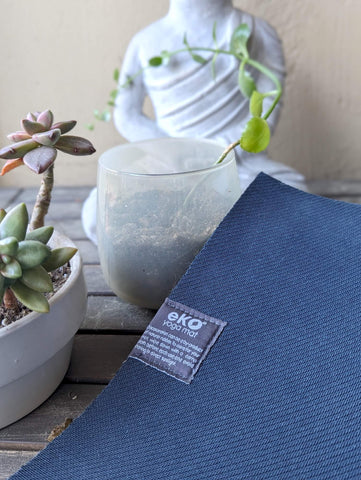 |
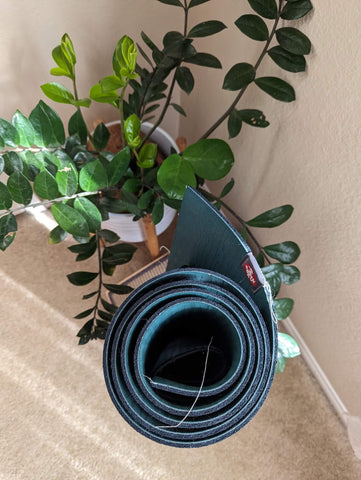 |
This all-natural rubber yoga mat has been a home run and a favorite in our sustainable yoga practice for over 5 years. Made with zero-waste manufacturing and renewable tree rubber, this eco-friendly yoga mat delivers on all fronts: sustainability, value, quality, and function.
The rippled surface texture channels those calming ocean vibes and offers great grip and traction, even for the sweatiest of flows. The natural rubber feels pleasantly cool against the skin and is hypoallergenic (bonus points for being latex-free!). This mat provides a generous amount of space and strikes a perfect balance between cushion and firmness.
The 5mm version is ideal as a dedicated home yoga mat because, let's be honest, it's on the heavier side. If travel or studio sessions aren't your thing, we recommend the lighter Manduka eKo Lite version for those on-the-go practices. Unless, of course, you fancy an extra workout carrying it to and from class!
PROS
- Eco-friendly and biodegradable
- 100% natural rubber, firm but cushy
- Somewhat waterproof and won’t absorb sweat
- Reliable traction even for sweatiest hands and feet
CONS
- A potent natural rubber smell when first opened, but it fades away after several uses.
- On the heavy side: not the best for frequent travel.
- Not recommended for outdoor use as the natural rubber is sensitive to UV.
Bonus points: pet-friendly

2. Best for Everyday Yogis: Organic Jute Yoga Mat - 5mm
If you value durability in an eco-friendly, sustainable yoga mat that brings raw, grippy power to your everyday practice, this is it. This mat is environmentally friendly, biodegradable, and non-toxic. It provides just the right amount of padding (feels a bit like memory foam) and feels grounding. The natural texture of organic jute is earthy-beautiful, functional and built for some serious Om.
Solid as the earth, it shows character by stubbornly unrolling itself during the first few days. It takes a bit of breaking in, but the grip gets better with every use.


PROS
- Stays put, even when things get sweaty
- Plants a tree for every mat sold
- Good for yoga on variety of surfaces from carpet to dirt
- Earthy look & feel
- Earth-friendly and non-toxic
CONS
- Weighty: not ideal if you cart your mat everywhere
- Shows the sweat: be prepared for some cleaning
3. Yoloha Cork Yoga Mat - best for hot yoga - 6 mm
This organic cork yoga mat brings a unique energy – warm under your touch, subtly textured for a naturally enhanced grip. Its traction actually improves with a bit of moisture, making it a hot yoga superstar. Plus, cork is naturally antimicrobial, a win for those wanting a more hygienic mat. Yoloha goes the extra mile with a sugarcane-based foam for added cushioning and sustainability.
We like the understated natural look of this yoga mat, which makes it our top pick for a men's yoga mat. It's got a satisfying support and density without feeling bulky, and is available in standard and larger sizes, perfect for taller yogis.
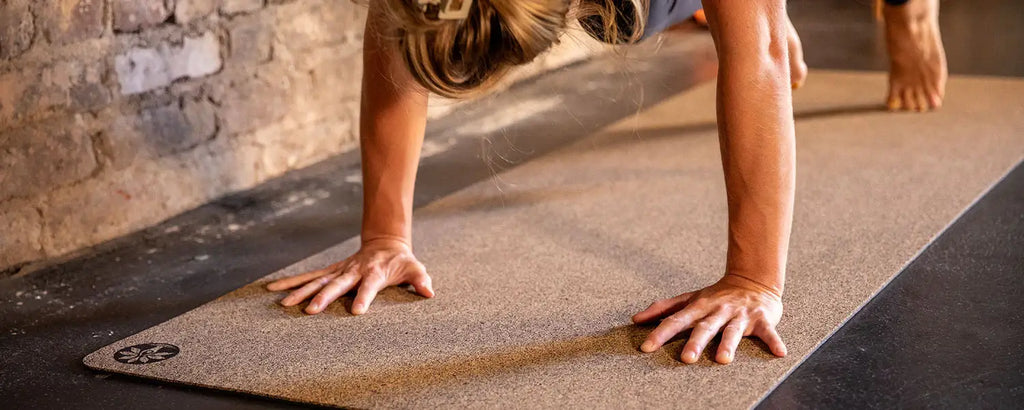

PROS
- Hot Yoga Hero: Handles sweat like a champ, no slipping
- 100% Vegan and Sustainable: Cork + plant-based foam for minimal impact.
- Odor Free and Antimicrobial: Cork naturally resists bacteria and smells.
- Top pick for men's yoga mat: understated look, solid-built, available in a larger size
CONS
- Cork's natural texture may show wear with heavy use.
- May feel less grippy when dry. Pro Tip: mist the mat where your hands and feet go.
Should You Buy? If you're ready for a high-performing sustainable yoga mat that prioritizes natural feel, superior grip (especially in hot yoga), and a clean, minimalist look, the Aura is worth considering, even with its higher price tag.
4. Yogasana organic cotton yoga mat
This yoga mat is hand-woven from GOTS-certified organic cotton and offers a grounding feel of the traditional. The natural fibers feel substantial and dense, providing a thin yet supportive layer of its own or over your primary yoga mat. This is not a soft and cushy mat if you like to have more padding for knees and elbows. But it packs light and thrives in outdoor conditions like sandy beach yoga or forest savasana.
Nice touch: the Yogasana mat arrives with a hand-signed card from the artisan who wove it in India.
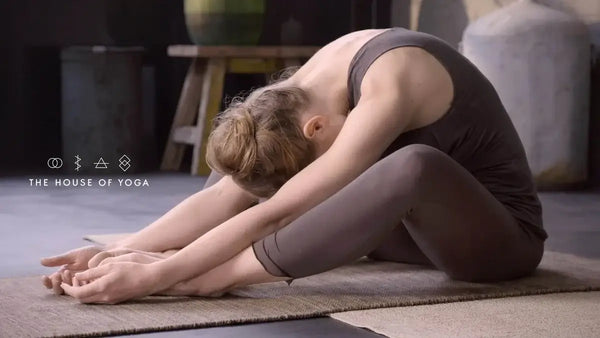
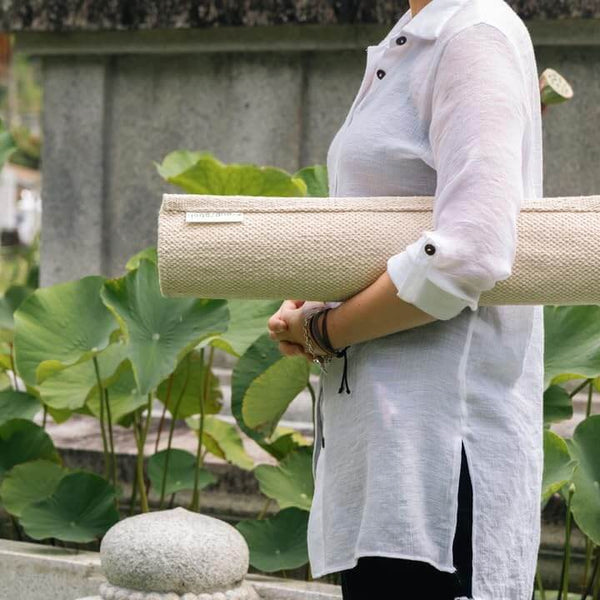
PROS
- GOTS-certified organic cotton
- Comes with a 15-year warranty
- Perfect for outdoor yoga, machine-washable
- Lightweight & travel-friendly
- $5 from every purchase goes toward essential school supplies for kids
CONS
- Not the best for smooth surfaces
- May shrink a little after the first wash
- Less cushioning and rougher feel
5. Suga recycled wetsuit yoga mat - 5 mm
This beauty is as "off the beaten mat" as it gets. One old surfing wetsuit becomes one SugaMat – reborn in California, ready to hold your practice. As we drifted into a deep savasana on this pebble-textured mat, we couldn’t help dreaming about the waves it had seen, the sunshine, the salty breeze on the skin and the joy of riding on water infused into this unconventional yoga mat.

Photo: Tyler Fox, a big wave surfer and environmental advocate - sugamats.com
Suga, a California brand, takes your retired wetsuits and even their old SugaMats, and spins them into new yoga mats through their proprietary recycling process. The brand originally started and was well received on Kickstarter a few years ago.
This thick and heavy mat feels more like a gym mat with a yoga mat grip. Our research shows that the original raw wetsuit material used in SugaMats includes polyurethanes and rubbers free of PVC and other toxic materials. Although more testing is needed to confirm its longevity, we love this concept of yoga mat reincarnation.
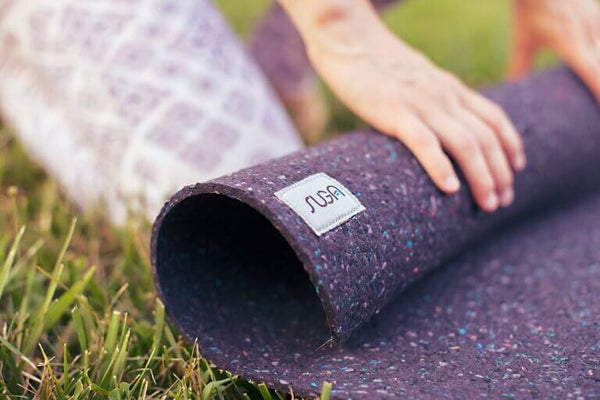
PROS
- Downward [salty] dog-approved grip.
- Each mat whispers of waves and wipeouts, deepening our connection with the nature.
- Yoga mat with unlimited lives with Suga C2G recycling program.
- Innovative closed-loop recycling means less waste.
- Made in the USA
CONS
- May shed over time
- On the heavy side
- Has a rougher feel
6. Jade Yoga Voyager Mat - best eco yoga mat for travel
Packing for yoga retreat destinations or squeezing a mat into a carry-on just got easier. This non-toxic natural rubber yoga mat weighs less than a tiny kitten and folds into a thin rectangle that can slip easily in any bag. It has the signature non-slip grip and stickiness of the regular Jade Yoga mat, but in a much thinner profile. Made of renewable natural rubber, this is a great travel companion for our warriors and sun salutations on-the-go.
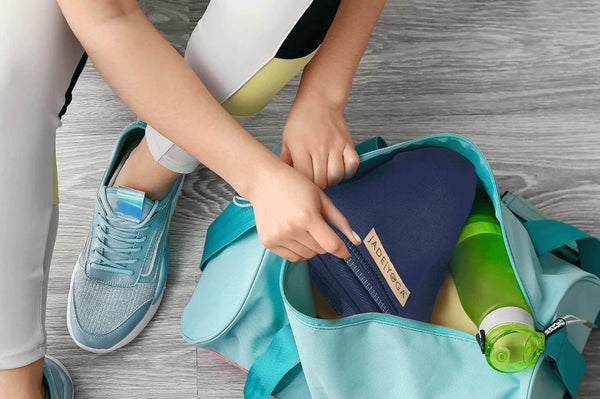
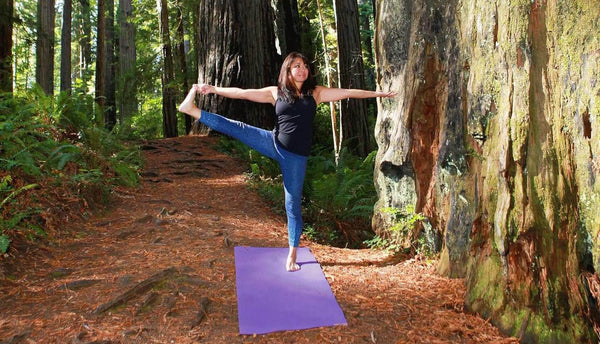
PROS
- Great price and value
- Perfect for travel and adventures, ultra lightweight and folds flat
- Plants a tree for every mat sold
- Signature sticky grip without toxic materials
CONS
- Contains latex so should be avoided by people with latex allergies
- May have strong rubber smell at first
- Minimal padding
7. Benevolence Recycled Mexican Blanket
This handwoven Mexican blanket offers a colorful, breathable alternative for your practice. It's lightweight, easy to carry and wash. We can find a dozen different ways to use it: a yoga and meditation mat (just fold it a few times for more height), beach towel or picnic blanket to name a few. We like to keep one of these in the car. Made of 100% recycled acrylic and cotton: this process reduces textile waste, conserves resources making this yoga blanket a more environmentally-friendly choice.
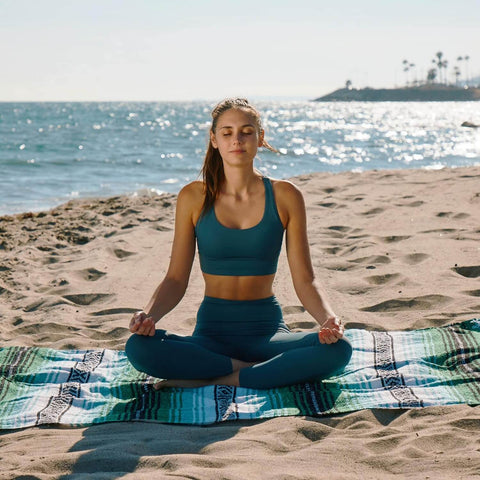
PROS
- Low price, very versatile
- Best for restorative practices like yin yoga
- Cozy feel and mood-lifting colors
CONS
- Not ideal for dynamic or power yoga styles
- Moves on sleek surfaces
Read more: The best meditation cushions
Eco-Friendly Yoga Mat Comparison Chart
Ready for a healthy and sustainable yoga mat? Here's a side-by-side comparison of the top eco-friendly options to help you decide.
| Feature | Manduka eKo | Jade Yoga Voyager | Yoloha Aura | Complete Unity | Yogasana |
| Material | Natural Rubber | Natural Rubber | Cork + Foam | Jute + Rubber | Organic Cotton |
| Thickness | 5mm | 1.6mm | 6mm | 4mm | Thin |
| Best For | All-around, Ashtanga & Vinyasa Yoga | Budget, Travel | Hot Yoga | Hatha & Flow Yoga | Outdoor, Restorative, Yin Yoga |
| Grip - Dry | Excellent | Excellent | Good | Good | Moderate |
| Grip - Wet | Excellent | Good | Excellent | Good | Moderate |
| Biodegradable | Yes | Yes | Yes | Yes | Yes |
| Recyclable | Yes | Yes | Yes | Yes | Yes |
| Pros | Grip, Durability, Eco | Ultra Light, Sticky, Folds Thin | Antimicrobial, Grip, Odor Free | Versatile, Plants Trees | Machine Washable, Light, Traditional |
| Cons | Heavy, Initial Odor | Minimal Cushioning | May Show Wear | Less Cushioning | Not for Sweaty Flows |
| Price | $$ | $ | $$ | $$$ | $$ |
| Where to Buy | View on Amazon | View on Amazon | View on Yoloha | View on Amazon | View on Amazon |
Sustainable Yoga Mat (Non) Buying Guide
Choose wisely
The greenest purchase is often the one you don't make. Before buying a new mat, honestly assess your needs. Think about where and how often you'll truly use it.
Invest in Quality
A well-made, multi-purpose yoga mat, even if pricier, is better than flimsy options you'll replace often. It's a long-term investment in your well-being.
Read labels
Look for mats labeled "PVC-free", "phthalate-free", “biodegradable” etc. For example, a yoga mat labeled as “Organic jute and PER” can be mostly PVC with a thin layer of jute on top. No thanks! Even better if a mat is certified by one of the green standards like GOTS or SafeMade.
Spark Joy Principle
Does the mat excite you? Do you like how it looks and feels? Following the golden principle of Marie Kondo’s The Japanese Art of Decluttering, enjoying the color, texture, and overall sensory vibe of your mat makes that sacred practice time even more special! Choose a mat you love to unroll.
Go for versatility
A multifunctional mat that suits your main practice style helps minimize the need for multiple purchases. We recommend investing in one stationary yoga mat for at home practice and a lighter travel version.
Thickness & Weight
Thinner mats (3mm or less) roll compactly and weigh less, making it a great choice for travelers and on-the-go yogis. For cushioning and for practicing on hard or uneven surfaces, go thicker (5mm+).
Get creative with DIY yoga mats
Enjoy those impromptu yoga moments – that ocean-view hotel balcony? Channel your inner yogi and grab a towel!

Mexican blankets in your Airbnb? Perfect! (Check out this eco-friendly one).
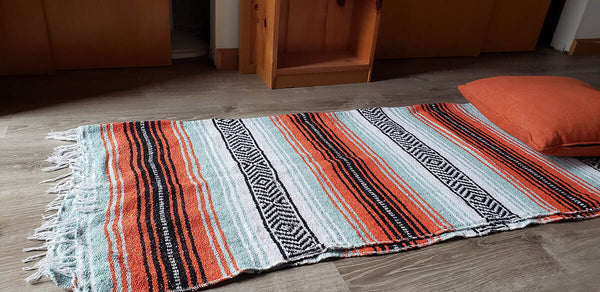
Heck, even a surfboard bag can become your zen zone.
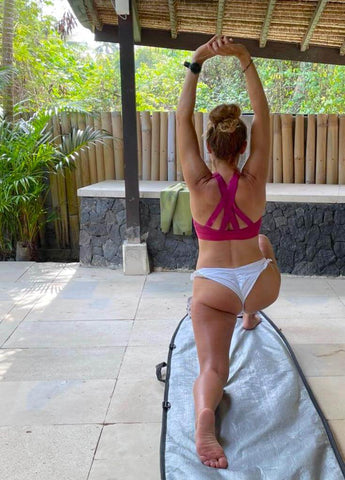
Because the best part of yoga?
It goes wherever you are.
Why Choose an Eco-Friendly Yoga Mat?
- Your Health (obviously): Polyvinyl chloride (PVC), heavy metals like lead and cadmium found in some yoga mats have been associated with increased risk of cancer, and may pose serious health risks.
California law requires companies to provide a disclosure about harmful chemicals in products, and those 'Proposition 65 WARNING: Cancer and Reproductive Harm' labels on yoga mats can give you pause. Ironic, isn't it? You practice yoga to feel healthy, yet your mat might itself be a hazard. It's time to ditch that worry and find a mat that supports your health, not harms it!
- Our Planet: Eco-mats use renewable or recycled materials, their sustainable production supports a healthier planet, aligning with the foundational yogic principle of Ahimsa (non-violence): causing no harm to any living being, including ourselves.
- Natural comfort and feel: The texture of natural materials like cork or organic cotton offer a feel-good and often grippier foundation for your practice that can enhance your flow and connection. We love how an earthy-hued jute yoga mat brings a grounding energy to our morning yoga ritual.
- Lasting Value: While some eco-mats have a higher initial cost, their quality ensures they'll serve you for years – a worthwhile investment in your practice and your well-being. Yoga mats can last for several years with proper care - we have some senior mats we have been carrying around for over a decade! Many practitioners replace them more frequently due to wear and tear, or simply wanting an upgrade. Choosing a durable eco-friendly mat reduces this cycle of waste.
What to Look for in an Eco-Friendly Yoga Mat
Sustainable Materials for yoga mats
Choose based on your practice and personal preferences. Natural rubber offers excellent grip but can wear faster and can be on the heavier side. Manduka eKo series and dual-sided Hugger Mugger rubber mat are great options.
Cork excels in sweaty flows and is antimicrobial.
Organic cotton feels soft but is less grippy – great for restorative yoga and deep savasanas. We can’t get enough of OkoLiving herbal yoga mats that are handloomed with organic cotton and infused with the bioactive healing plants. Like Ayurveda on a yoga mat.
Other options include jute (Maji Sports), hemp (Khusi), sugarcane (Yoloha) and even recycled surfing wetsuits! (Suga)
Standards for ecological and social responsibility
Look for reputable certifications like OEKO-TEX for peace of mind. They guarantee rigorous testing for harmful substances to ensure sustainability and safety aren’t just marketing buzzwords.
- Global Organic Textile Standard (GOTS) is the highest global standard for ecological and social responsibility through the entire textile supply chain for both environmental and human safety.
- OEKO-TEX (skin-safe): Every product bearing the OEKO-TEX® Standard 100 label is certified as having passed safety tests and is free from harmful substances. OEKO-TEX certified products are safe even for babies if you are looking to get your little one on a yoga mat.
- UL Greenguard Certification means that both the yoga mat and its manufacturing process were tested and reviewed for over 10,000 chemicals and meet industry standards for low emissions.
-
MADE SAFE® Certified — literally means that a product is certified non-toxic through a rigorous scientific screening process that only allows the use of safe ingredients that are not known or suspected to harm human health, animals, aquatic life, or ecosystems. Avocado's organic yoga mat is a great example of commitment to sustainability:

What toxic materials to avoid in a yoga mat?
Unfortunately, plastic yoga mats often contain chemicals that raise health and environmental concerns. Packaging and marketing materials may not always tell the whole story so here's what to watch out for.
- PVC (Polyvinyl Chloride) in yoga mats: The most common, and most problematic plastic in yoga mats. PVC requires harmful softening chemicals called phthalates, which have been linked to hormone disruption, reproductive, immune and other health problems according to the National Institute of Environmental Health Sciences.
Did you know that Petroleum-based plastics, such as PVC, can take over 500 years to decompose, and even then they never fully disappear becoming harmful microplastics.
- Bisphenol A (BPA): Another known endocrine system disruptor to avoid.
-
Polymer environmental resin (PER): a PVC’s little brother. You may see it marketed as an eco-friendly alternative to PVC, but beware of greenwashing.
A research by Ecology Center found some yoga mats marketed as “eco-friendly” and “biodegradable” PER were made of PVC. The term PER basically indicates PVC that does not contain phthalates. While PER is a step forward, there are still plenty of health concerns in the production, long-term use and disposal of PER products. - Heavy Metals: synthetic yoga mats may contain heavy metals like lead or cadmium used stabilizers in plastics like PVC. These can leach into the skin or be released into the environment.
- Thermoplastic Elastomers (TPE): this material has a generally safe reputation and is even used in medical and food industries. The problem is TPE is essentially a mix of rubber and plastic, the exact composition of which is often not disclosed. So you can't always tell what exactly is in a TPE mat. Similarly to those "fragrance" blends in beauty products – companies can hide harmful ingredients in there.
- Ethylene-Vinyl Acetate Foam (EVA): seems soft and harmless, but watch out – it can off-gas chemicals called volatile organic compounds (VOCs) that vaporize at room temperature. Meaning they go right into the air you breathe during yoga. They've been linked to headaches, dizziness, and respiratory problems.
Frequently Asked Questions
How do I clean an eco-friendly yoga mat without chemicals?
No need for fancy mat sprays! Pro tip: Want insider knowledge on how we clean spaces naturally at Vipassana silent meditation retreats? Vinegar! Use this easy DIY yoga mat spray recipe: Mix equal parts water and vinegar (for odor-fighting and antimicrobial power) in a clean spray bottle. Shake and spritz!
Why do some eco-friendly yoga mats have a strong smell?
Some eco mats, especially those made from natural rubber, may have a noticeable odor when first opened. This smell usually dissipates after a few uses and is generally less intense than the chemical smells from synthetic mats.
Are yoga mats safe?
Yoga mats can be safe if they are made from non-toxic, eco-friendly materials. Conventional mats made from PVC may contain harmful chemicals that can be released during use. Eco-friendly mats made from natural rubber, cork, or organic cotton are safer options as they do not contain these toxic substances.
What is the best natural material for a yoga mat?
The best natural material for a yoga mat depends on your needs. Natural rubber is great for durability and grip, cork offers excellent antimicrobial properties, and organic cotton provides a soft, comfortable surface. Each material has its unique benefits.
What is the healthiest material for a yoga mat?
Natural rubber, cork, and organic cotton are excellent choices as they are free from harmful chemicals and provide a safe, supportive surface for your practice. These materials are also biodegradable and environmentally friendly, contributing to overall wellness.
Are eco-friendly yoga mats more expensive than regular mats?
Eco-friendly yoga mats can be more expensive than synthetic mats due to the cost of sustainable materials and ethical manufacturing practices. However, they usually last longer and offer health benefits that make them a worthwhile investment.
What are the best eco-friendly yoga mat brands?
Some of the best eco-friendly yoga mat brands include Manduka, Jade Yoga, Yoloha and Oko Living. These brands are known for their commitment to sustainability and high-quality products.
How do eco-friendly yoga mats contribute to sustainability?
Eco-friendly yoga mats contribute to sustainability by using renewable or recycled resources, reducing waste through biodegradable materials, and minimizing the environmental impact during production. Many brands also support environmental initiatives and fair trade practices.
Can I recycle my old yoga mat?
Many eco yoga mats can be recycled. Some brands offer take-back programs where you can return your old mat for recycling. Additionally, you can repurpose your old mat for household uses like padding for kneeling during gardening or as a non-slip surface for pet bowls.
Research References
- Vinyl Chloride - Cancer-Causing Substances - National Cancer Institute
- Why You Should Avoid PVC Products - EcoWatch
- Plastics and carcinogenesis: The example of vinyl chloride
- United Nations: Plastic is Forever
- Risks Associated with the Presence of Polyvinyl Chloride in the Environment and Methods for Its Disposal and Utilization
- Yoga Mats Testing Reveals Greenwashing - EcoCenter
- Endocrine Disruptors (BPA, Phthalates, PER etc) - National Institute of Environmental Health Sciences
- What Is Thermoplastic Elastomer (TPE)? Is it Safe to Use?
- Volatile Organic Compounds' Impact on Indoor Air Quality
- The Proposition 65 Prohibited Toxic Chemicals - Official List
- Non Toxic Certified Prohibited Substances List
- Phthalates and Their Impacts on Human Health







Leave a comment